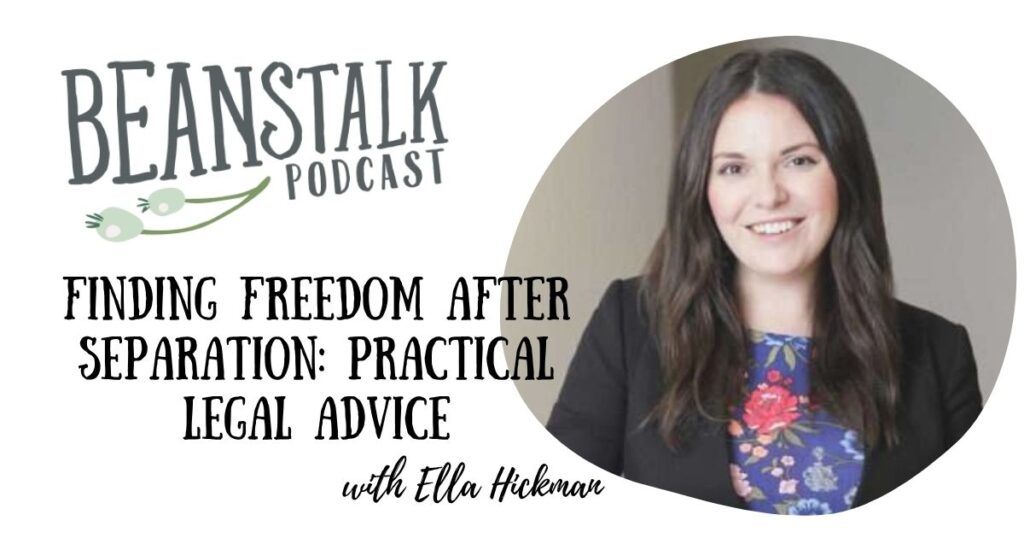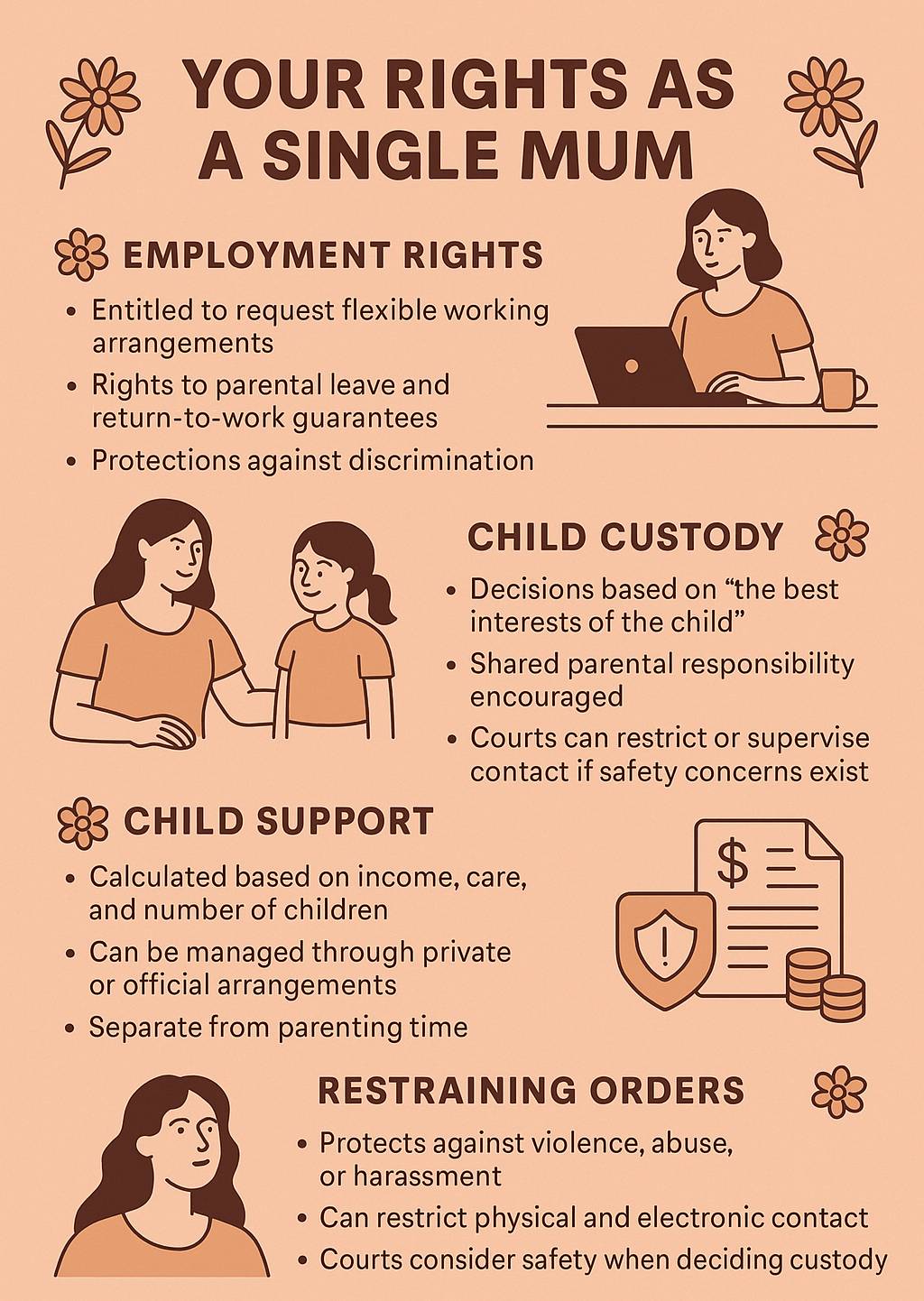

It’s no secret that becoming a single mother is a life-changing experience. Whether the transition is the result of a divorce, separation, or other circumstances, it’s a path filled with its fair share of emotional, financial, and legal challenges. Understanding your rights as a single mum is critical — especially when it comes to employment, custody, and child support laws in Australia. Being well-informed helps you protect both yourself and your children, make empowered decisions, and build a stable future.
Many single mums juggle work, childcare responsibilities, and recovery from the breakdown of a relationship — all while trying to navigate complex legal processes. From ensuring fair custody arrangements and child support payments to securing your income and safety, the law in Australia provides a clear framework to support and protect single mothers (and fathers) during these transitions. Knowing your entitlements can make a profound difference in how you move forward.
Ella Hickman, from Hickman Family Lawyers in Perth, talks us through your rights as a single mum, looking at your working rights, custody laws, child support, restraining orders, and spousal maintenance when you separate.

Listen to Ella Hickman on the Beanstalk Mums Podcast as she breaks down Your Rights as a Single Mum from custody and child support to workplace protections and personal safety
Empower yourself with clarity confidence and real world guidance
👉 Tune in now to the Beanstalk Mums Podcast
Your Rights as a Single Mum: Navigating Employment, Custody, and Support Laws
In Australia, family law recognises the unique needs and responsibilities of single mothers. When a relationship ends — particularly where children are involved — a range of legal issues may come into play, including parenting arrangements, financial support, employment rights, and personal safety.
As a single mother, you may need to negotiate parenting time, secure child support from the other parent, access spousal maintenance if applicable, and maintain your career without facing discrimination. It’s important to know that the law is designed to protect your rights and provide a pathway to stability and security, not just for you but for your children as well.
Understanding these laws — and how they interact — helps you make clear and confident decisions during what can often be a turbulent time. Whether you’re co-parenting, navigating legal proceedings, or dealing with financial or career uncertainty, the legal system offers mechanisms to support you.
Working Rights for Single Mothers in Australia
Single mothers in Australia have the same legal protections in the workplace as any other employee — but there are also specific entitlements that can help you balance work and parenting. Under the Fair Work Act 2009, you are entitled to request flexible working arrangements if you have parenting responsibilities for a child of school age or younger. This includes changes to hours, patterns of work, or locations such as working from home.
You also have the right to parental leave, including unpaid leave and return-to-work guarantees, even after a separation. If you are pregnant, on parental leave, or requesting flexible work, it is unlawful for your employer to treat you unfairly or terminate your employment because of these responsibilities.
Discrimination on the basis of family responsibilities is prohibited under both federal and state anti-discrimination laws. If you are treated unfairly at work because you’re a single mother — for example, being overlooked for a promotion, denied flexibility, or dismissed — you may have legal recourse.
If you’re receiving Centrelink support or parenting payments, it’s also essential to understand how changes in your working hours or income might affect your entitlements. Balancing work and parenting alone is never easy, but the law is on your side when it comes to protecting your role in both.

Child Custody Law in Australia
When parents separate, child custody — legally referred to as parenting arrangements — becomes a major focus. Australian family law does not automatically give one parent more rights than the other. Instead, the Family Law Act 1975 prioritises the best interests of the child, including their right to a meaningful relationship with both parents, where safe and appropriate.
Single mothers often assume they will automatically have full custody, but this isn’t always the case. The law encourages shared parental responsibility unless there is a valid reason not to, such as family violence or safety concerns. Parental responsibility is about making long-term decisions, not necessarily the amount of time a child spends with each parent.
You can make parenting arrangements through an informal agreement, a parenting plan, or consent orders made by the court. If agreement isn’t possible, you may need to go through family dispute resolution (aka family mediation) before applying to court.
If you’re concerned about your child’s safety with the other parent — due to domestic violence, substance use, or neglect — you can ask the court for orders that limit or supervise contact. It’s important to understand your rights here and seek legal advice to ensure your child’s wellbeing remains protected.
How Child Support Law in Australia Protects Your Rights as a Single Mum
Child support in Australia is designed to ensure that both parents contribute to the financial needs of their children after separation. The Department of Services Australia (Child Support Agency) manages most child support arrangements and calculates payments based on each parent’s income, the care each provides, and the number of children involved.
As a single mum, you can choose to have a private agreement with the other parent or go through the Child Support Agency for an official assessment and payment collection. This can be especially useful when relationships are strained or if there are concerns about consistent payment.
Child support can cover basic living expenses such as housing, food, clothing, education, and medical care. In some cases, additional costs like extracurricular activities or private schooling can be included by mutual agreement.
If the other parent isn’t paying or is underpaying child support, you can ask the agency to enforce payment through income garnishing, tax return interception, or legal action. It’s important to keep records of care arrangements and communication as this can affect assessments.
Remember that child support is separate from parenting time — a parent cannot withhold access to children simply because the other parent isn’t paying support, and vice versa.
Restraining Orders: Your Right To Safety
Sadly, for some single mothers, separation is accompanied by concerns about personal safety or the safety of their children. If you are experiencing domestic violence, abuse, or harassment from your ex-partner, you have a legal right to seek protection through the courts.
In Western Australia, a Family Violence Restraining Order (FVRO) can prevent a person from approaching or contacting you and your children. These orders are taken seriously and can include provisions for your home, school pickups, and even electronic contact like texts or emails.
Applying for a restraining order does not require a criminal charge to be laid, though breaching the order is a criminal offence. If you’re in immediate danger, always contact police first. You can then follow up with legal support to formalise protection measures.
It’s important to know that seeking a restraining order does not affect your ability to access family law services or parenting arrangements. Courts can consider the presence of violence or abuse when making decisions about custody and contact, always with a focus on protecting the child’s safety.
No one should have to live in fear — especially when trying to care for children. Legal protections exist to help you rebuild your life free from intimidation and harm.
Find out more about family violence orders according to your state here.

Spousal Maintenance Law in Australia
Spousal maintenance is financial support paid by one former partner to the other after separation or divorce, in situations where one person cannot adequately support themselves. While it’s different to child support, it can be a vital lifeline for many single mothers, particularly if you left the workforce to raise children or have limited income.
Under the Family Law Act 1975, a former spouse may be required to provide financial assistance if they have the means and the other party is unable to meet reasonable living expenses. This may be due to age, health, or parenting responsibilities that make it difficult to earn a sufficient income.
You can apply for spousal maintenance through the court or negotiate an agreement privately. Payments may be made as a lump sum or on an ongoing basis, and can be tailored to your needs — for example, until children reach a certain age or you return to work.
There are strict time limits for applying for spousal maintenance: 12 months from the date your divorce becomes final, or two years from the end of a de facto relationship. So, if you think you may be entitled to support, it’s important to act promptly. Spousal maintenance can ease financial pressure and help you focus on caring for your children, rebuilding your career, or pursuing further education.
Your Rights as a Single Mum Can Empower Your Next Chapter
Being a single mum is an enormous responsibility, and the legal aspects of separation can frequently feel overwhelming. But you don’t have to face it alone.
Understanding your rights — at work, as a parent, and in terms of financial and personal safety — empowers you to make informed decisions and protect your family’s wellbeing.
While online information is helpful, every family’s situation is unique, and the law can be complex. Seeking support from an experienced and trusted family lawyer can ensure you’re fully informed of your rights and entitlements, and help you take confident steps toward a stable and secure future for yourself and your children.
Read more from Ella here: Coparenting with a Toxic Ex: Know Your Rights & Expert Advice On How To Keep Legal Boundaries Protected



